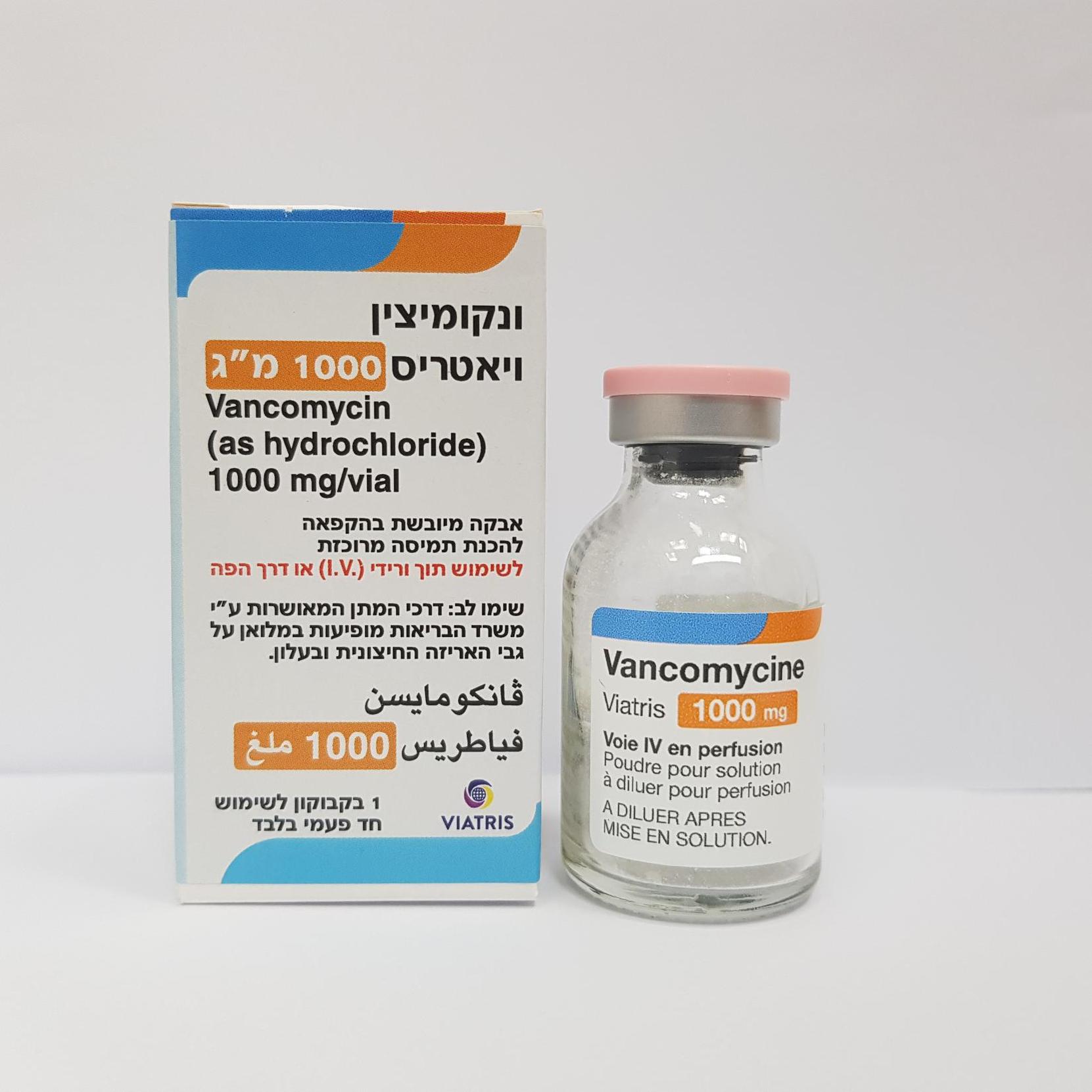Quest for the right Drug

ונקומיצין ויאטריס 1000מ"ג VANCOMYCIN VIATRIS 1000 MG. (VANCOMYCIN AS HYDROCHLORIDE)
תרופה במרשם
תרופה בסל
נרקוטיקה
ציטוטוקסיקה
צורת מתן:
תוך-ורידי, פומי : I.V, ORAL
צורת מינון:
אין פרטים : LYOPHILIZED POWDER FOR CONCENTRATED SOLUTION
עלון לרופא
מינוניםPosology התוויות
Indications תופעות לוואי
Adverse reactions התוויות נגד
Contraindications אינטראקציות
Interactions מינון יתר
Overdose הריון/הנקה
Pregnancy & Lactation אוכלוסיות מיוחדות
Special populations תכונות פרמקולוגיות
Pharmacological properties מידע רוקחי
Pharmaceutical particulars אזהרת שימוש
Special Warning עלון לרופא
Physicians Leaflet
Adverse reactions : תופעות לוואי
4.8. Undesirable effects Summary of the Safety profile The most common adverse reactions are phlebitis, pseudo-allergic reactions and flushing of the upper body (“red-neck syndrome”) in connection with too rapid intravenous infusion of vancomycin. Severe cutaneous adverse reactions (SCARs), including Stevens-Johnson syndrome (SJS), toxic epidermal necrolysis (TEN), drug reaction with eosinophilia and systemic symptoms (DRESS) and acute generalized exanthematous pustulosis (AGEP) have been reported in association with vancomycin treatment (see section 4.4). The absorption of vancomycin from the gastrointestinal tract is negligible. However, in severe inflammation of the intestinal mucosa, especially in combination with renal insufficiency, adverse reactions that occur when vancomycin is administered parenterally may appear. Tabulated List of Adverse reactions Within each frequency grouping, undesirable effects are presented in order of decreasing seriousness. The adverse reactions listed below are defined using the following MedDRA convention and system organ class database: Very common (≥ 1/10); common (≥ 1/100 to < 1/10); uncommon (≥ 1/1,000 to < 1/100); rare (≥ 1/10,000 to < 1/1,000); very rare (< 1/10,000), not known (cannot be estimated from the available data). System organ class Frequency Adverse reaction Blood and the lymphatic system disorders Rare Reversible neutropenia1, agranulocytosis, eosinophilia, thrombocytopenia, pancytopenia. Immune system disorders: Rare Hypersensitivity reactions, anaphylactic reactions2 Ear and labyrinth disorders: Uncommon Transient or permanent loss of hearing4 Rare Vertigo, tinnitus3, dizziness Cardiac disorders Very rare Cardiac arrest Vascular disorders: Common Decrease in blood pressure Rare Vasculitis Respiratory, thoracic and mediastinal disorders: Common Dyspnoea, stridor Gastrointestinal disorders Rare Nausea Very rare Pseudomembranous enterocolitis Not known Vomiting, Diarrhoea Skin and subcutaneous tissue disorders: Common Flushing of the upper body (“red man syndrome”), exanthema and mucosal inflammation, pruritus, urticaria Very rare Exfoliative dermatitis, Stevens-Johnson syndrome, Toxic epidermal necrolysis (TEN), Linear IgA bullous dermatosis Not known Eosinophilia and systemic symptoms (DRESS syndrome (drug-induced hypersensitivity syndrome)) AGEP (Acute Generalized Exanthematous Pustulosis) Renal and urinary disorders: Common Renal insufficiency manifested primarily by increased serum creatinine and serum urea Rare Interstitial nephritis, acute renal failure. Not known Acute tubular necrosis General disorders and administration site conditions: Common Phlebitis, redness of the upper body and face. Rare Drug fever, shivering, pain and muscle spasm of the chest and back muscles Description of selected adverse drug reactions 1Reversible neutropenia usually starting one week or more after onset of intravenous therapy or after total dose of more than 25 g. 2During or shortly after rapid infusion anaphylactic/anaphylactoid reactions including wheezing may occur. The reactions abate when administration is stopped, generally between 20 minutes and 2 hours. Vancomycin should be infused slowly (see sections 4.2 and 4.4). Necrosis may occur after intramuscular injection. 3Tinnitus, possibly preceding onset of deafness, should be regarded as an indication to discontinue treatment. 4Ototoxicity has primarily been reported in patients given high doses, or in those on concomitant treatment with other ototoxic medicinal product like aminoglycoside, or in those who had a pre-existing reduction in kidney function or hearing. Paediatric population The safety profile is generally consistent among children and adult patients. Nephrotoxicity has been described in children, usually in association with other nephrotoxic agents such as aminoglycosides. Reporting of suspected adverse reactions Reporting suspected adverse reactions after authorisation of the medicinal product is important. It allows continued monitoring of the benefit/risk balance of the medicinal product. Any suspected adverse events should be reported to the Ministry of Health according to the National Regulation by using an online form: https://sideeffects.health.gov.il/ and by email to the Registration Holder’s Patient Safety Unit at: drugsafety@neopharmgroup.com

שימוש לפי פנקס קופ''ח כללית 1994
לא צוין
תאריך הכללה מקורי בסל
01/01/1995
הגבלות
תרופה מוגבלת לשימוש בבתי חולים או אשפוז יום
מידע נוסף
